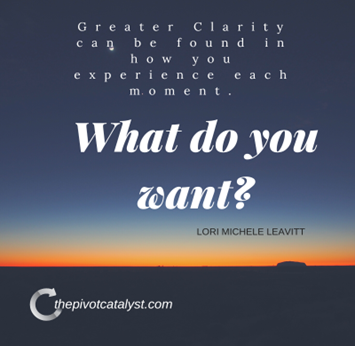Before you can focus on what matters most, first define what matters! What do you want?
Your calendar is full. You feel busy. Yet is any part of what you have planned for today moving you toward a better future? As a leader, is what you have planned for today moving the organization toward a better future?
To find fulfillment from your daily work, align what you want with what is needed most from you in your role. And then start scheduling in what will move you toward what you want.
To ensure that every person in the organization is taking their best next step today, in alignment with strategic objectives, each person must know those objectives and how their role fits with those objectives.
In this series I’m sharing David Meltzer’s 5 Daily Practices, and adding context for leaders. You (and all) need to be clear about what you want.
Daily practice, to be more successful
Here are the 5 Daily Practices.
Get clear about –
- What you want
- Who can help
- How “who” & “what” fit into the reality of today
- Your priorities for today (also see Part I)
- How “what,” “who,” “how,” and “priorities” fit your purpose
For this post (and all posts in this series), I’ll put the 5 Daily Practices into a lens of leadership. In this way you can leverage these 5 Daily Practices to gain Aligned Momentum in life and work, personally, and for the organization.
Successful people proactively plan each day so that what they spend time on is moving them forward. Here, when I say “plan,” I don’t mean that it has to take a lot of time.
The amount of time you need to plan a day—for alignment and momentum toward a better future—will directly correlate with how clear you are about what you want in the future.
What do you want (to be, do, have) personally?
What will you do today that moves you forward toward personal goals, or fulfills you in a way that allows you to be at your best?
What you want for you may include personal (including career) achievements, attainments, and experiences. Include what you want to give, and to receive.
Receiving can be the toughest to “pencil-in.” Considering what you want to receive is going to help you with the next four steps.
Receiving might include appreciation, position, or financial gain. Receiving could mean flexibility in your calendar to allow time for deep thought and creativity, family, wellness, learning, etc.
What do you want (to be, do, have) in your role?
What will you do today in your role to create the greatest forward momentum toward shared goals? These goals will be aligned with what the organization needs most from your role, either by making progress toward strategic objectives or maintaining optimum operational performance.
For example, if you lead a financial reporting team and it is time for the monthly close, then you may have close activities on your calendar. And while those seem to not drive progress toward strategic objectives, this activity is necessary for operational performance, compliance, and decision support—which are critical to achieving strategic objectives, together.
Align what you want with what your role needs most from you.
I encourage you to tighten the alignment between what you want and what your role needs from you at least every two weeks.
Let’s take a simple example. You say: “I want more wealth.” And I’ll not ask, “What will you do today that will bring more wealth in the future.” I’ll ask, “Why do you want more wealth?”
Your response may be what you really want in the future, or it may, like wealth, be just a step toward what you really want.
So, let’s say that your next response is “Because I want to vacation more.” I’m going to ask “why” again.
And you say, “Because I need more breaks from work in order to think and create” or “Because I want to show my friends how successful I am” or “Because it’s the time I have with my family” or…
These third responses are most likely what you really want.
Once you get to the core of what you want, then consider how what you want for you fits with what is needed from you in your role at work.
And then look at how you might be better spending your days to achieve alignment with what matters, and creating greater momentum towards it.
Note that calendar “to dos” tend to be tactical; they are near-term, specific, and typically time bound. “What you want” is strategic; it is longer-term, you can see it but don’t know all the details of how to get there, and it continues until or unless it is proven to not be leading toward a better future.
The space on your calendar does not need to be filled with tactical “to dos.”
Your best next step
For your “Your 1 Best Next Step,” before your day starts tomorrow, take 5-15 minutes to consider what you want and make sure the activities on your calendar reflect this. If you are not in control of your calendar yet, you may need to do this a week in advance.

